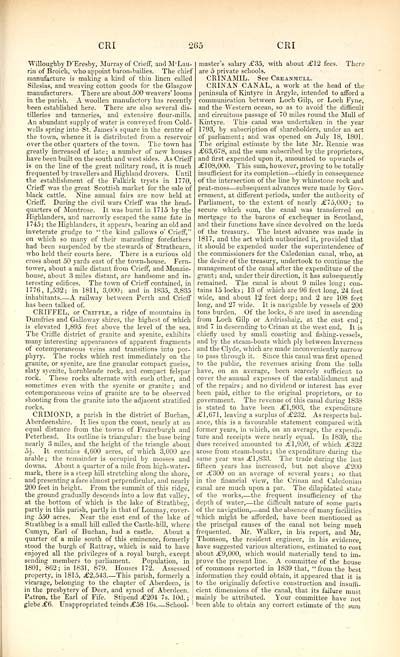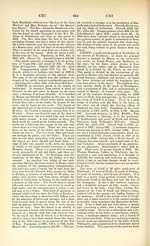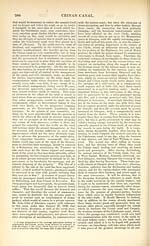Topographical, statistical, and historical gazetteer of Scotland > Volume 1
(347) Page 265
Download files
Complete book:
Individual page:
Thumbnail gallery: Grid view | List view

CRI
265
CRI
Willoughby D'Eresby, Murray of Crieff, ami M'Lau-
rin of Broich, who appoint baron-bailies. The chief
manufacture is making a kind of thin linen called
Silesias, and weaving cotton goods for the Glasgow
manufacturers. There are about 500 weavers' looms
in the parish. A woollen manufactory has recently
been established here. There are also several dis-
tilleries and tanneries, and extensive flour-mills.
An abundant supply of water is conveyed from Cold-
wells spring into St. James's square in the centre of
the town, whence it is distributed from a reservoir
over the other quarters of the town. The town has
greatly increased of late; a number of new houses
have been built on the south and west sides. As Crieff
is on the line of the great military road, it is much
frequented by travellers and Highland drovers. Until
the establishment of the Falkirk trysts in 1770,
Crieff was the great Scottish market for the sale of
black cattle. Nine annual fairs are now held at
Crieff. During the civil wars Crieff was the head-
quarters of Montrose. It was burnt in 1715 by the
Highlanders, and narrowly escaped the same fate in
1 745 ; the Highlanders, it appears, bearing an old and
inveterate grudge to "the kind gallows o' Crieff,"
on which so many of their marauding forefathers
had been suspended by the stewards of Strathearn,
who held their courts here. There is a curious old
cross about 50 yards east of the town-house. Fern-
tower, about a mile distant from Crieff, and Monzie-
house, about 3 miles distant, are handsome and in-
teresting edifices. The town of Crieff contained, in
1776,1,532; in 1811, 3,000; and in 1S35, 3,835
inhabitants A railway between Perth and Crieff
has been talked of.
CRIFFEL, or Crtffle, a ridge of mountains in
Dumfries and Galloway shires, the highest of which
is elevated 1,895 feet above the level of the sea.
The Criffle district of granite and syenite, exhibits
many interesting appearances of apparent fragments
of cotemporaneous veins and transitions into por-
phyry. The rocks which rest immediately on the
granite, or syenite, are fine granular compact gneiss,
slaty syenite, hornblende rock, and compact felspar
rock. These rocks alternate with each other, and
sometimes even with the syenite or granite ; and
cotemporaneous veins of granite are to be observed
shooting from the granite into the adjacent stratified
rocks.
CRIMOND, a parish in the district of Buchan,
Aberdeenshire. It lies upon the coast, nearly at an
equal distance from the towns of Frazerburgh and
Peterhead. Its outline is triangular : the base being
nearly 3 miles, and the height of the triangle about
5J. It contains 4,600 acres, of which 3,000 are
arable ; the remainder is occupied by mosses and
downs. About a quarter of a mile from high- water-
mark, there is a steep hill stretching along the shore,
and presenting a face almost perpendicular, and nearly
200 feet in height. From the summit of this ridge,
the ground gradually descends into a low flat valley,
at the bottom of which is the lake of Strathbeg,
partly in this parish, partly in that of Lonmay, cover-
ing 550 acres. Near the east end of the lake of
Strathbeg is a small hill called the Castle-hill, where
Cumyn, Earl of Buchan, had a castle. About a
quarter of a mile south of this eminence, formerly
stood the burgh of Rattray, which is said to have
enjoyed all the privileges of a royal burgh, except
sending members to parliament. Population, in
1801, 862 ; in 1831, 879. Houses 172. Assessed
property, in 1815, .£2,543 This parish, formerly a
vicarage, belonging to the chapter of Aberdeen, is
in the presbytery of Deer, and synod of Aberdeen.
Patron, the Earl of Fife. Stipend £204 7s. lOd. ;
glebe £6. Unappropriated teinds £58 16s School-
master's salary £35, with about .£12 fees. There
are 5 private schools.
CRINAMIL. See CREANBirjix.
CRINAN CANAL, a work at the head of the
peninsula of Kintyre in Argyle, intended to afford a
communication between Loch Gilp, or Loch Fyne,
and the Western ocean, so as to avoid the difficult
and circuitous passage of 70 miles round the Mull of
Kintyre. This canal was undertaken in the year
1793, by subscription of shareholders, under an act
of parliament; and was opened on July 18, 1801.
The original estimate by the late Mr. Reimie was
£63,678, and the sum subscribed by the proprietors,
and first expended upon it, amounted to upwards of
£108,000. This sum, however, proving to be totally
insufficient for its completion — chiefly in consequence
of the intersection of the line by whinstone rock and
peat-moss — subsequent advances were made by Gov-
ernment, at different periods, under the authority of
Parliament, to the extent of nearly £75,000; to
secure which sum, the canal was transferred on
mortgage to the barons of exchequer in Scotland,
and their functions have since devolved on the lords
of the treasury. The latest advance was made in
1817, and the act which authorized it, provided that
it should be expended under the superintendence of
the commissioners for the Caledonian canal, who, at
the desire of the treasury, undertook to continue the
management of the canal after the expenditure of the
grant ; and, under their direction, it has subsequently
remained. The canal is about 9 miles long; con-
tains 15 locks; 13 of which are 96 feet long, 24 feet
wide, and about 12 feet deep; and 2 are 108 feet
long, and 27 wide. It is navigable by vessels of 200
tons burden. Of the locks, 8 are used in ascending
from Loch Gilp or Ardrisshaig, at the east end ;
and 7 in descending to Crinan at the west end. It is
chiefly used by small coasting and fishing-vessels,
and by the steam-boats which ply between Inverness
and the Clyde, which are made inconveniently narrow
to pass through it. Since this canal was first opened
to the public, the revenues arising from the tolls
have, on an average, been scarcely sufficient to
cover the annual expenses of the establishment and
of the repairs ; and no dividend or interest has ever
been paid, either to the original proprietors, or to
government, The revenue of this canal during 1838
is stated to have been £1,903, the expenditure
£1,671, leaving a surplus of £232. As respects bal-
ance, this is a favourable statement compared with
former years, in which, on an average, the expendi-
ture and receipts were nearly equal. In 1839, the
dues received amounted to £ 1,950, of which £322
arose from steam-boats ; the expenditure during the
same year was £1,833. The trade during the last
fifteen years has increased, but not above £200
or £300 on an average of several years ; so that
in the financial view, the Crinan and Caledonian
canal are much upon a par. The dilapidated state
of the works, — the frequent insufficiency of the
depth of water, — the difficult nature of some parts
of the navigation, — and the absence of many facilities
which might be afforded, have been mentioned as
the principal causes of the canal not being much
frequented. Mr. Walker, in his report, and Mr.
Thomson, the resident engineer, in his evidence
have suggested various alterations, estimated to cost
about £9,000, which would materially tend to im-
prove the present fine. A committee of the house
of commons reported in 1839 that, " from the best
information they could obtain, it appeared that it is
to the originally defective construction and insuffi-
cient dimensions of the canal, that its failure must
mainly be attributed. Your committee have not
been able to obtain any correct estimate of the sum
265
CRI
Willoughby D'Eresby, Murray of Crieff, ami M'Lau-
rin of Broich, who appoint baron-bailies. The chief
manufacture is making a kind of thin linen called
Silesias, and weaving cotton goods for the Glasgow
manufacturers. There are about 500 weavers' looms
in the parish. A woollen manufactory has recently
been established here. There are also several dis-
tilleries and tanneries, and extensive flour-mills.
An abundant supply of water is conveyed from Cold-
wells spring into St. James's square in the centre of
the town, whence it is distributed from a reservoir
over the other quarters of the town. The town has
greatly increased of late; a number of new houses
have been built on the south and west sides. As Crieff
is on the line of the great military road, it is much
frequented by travellers and Highland drovers. Until
the establishment of the Falkirk trysts in 1770,
Crieff was the great Scottish market for the sale of
black cattle. Nine annual fairs are now held at
Crieff. During the civil wars Crieff was the head-
quarters of Montrose. It was burnt in 1715 by the
Highlanders, and narrowly escaped the same fate in
1 745 ; the Highlanders, it appears, bearing an old and
inveterate grudge to "the kind gallows o' Crieff,"
on which so many of their marauding forefathers
had been suspended by the stewards of Strathearn,
who held their courts here. There is a curious old
cross about 50 yards east of the town-house. Fern-
tower, about a mile distant from Crieff, and Monzie-
house, about 3 miles distant, are handsome and in-
teresting edifices. The town of Crieff contained, in
1776,1,532; in 1811, 3,000; and in 1S35, 3,835
inhabitants A railway between Perth and Crieff
has been talked of.
CRIFFEL, or Crtffle, a ridge of mountains in
Dumfries and Galloway shires, the highest of which
is elevated 1,895 feet above the level of the sea.
The Criffle district of granite and syenite, exhibits
many interesting appearances of apparent fragments
of cotemporaneous veins and transitions into por-
phyry. The rocks which rest immediately on the
granite, or syenite, are fine granular compact gneiss,
slaty syenite, hornblende rock, and compact felspar
rock. These rocks alternate with each other, and
sometimes even with the syenite or granite ; and
cotemporaneous veins of granite are to be observed
shooting from the granite into the adjacent stratified
rocks.
CRIMOND, a parish in the district of Buchan,
Aberdeenshire. It lies upon the coast, nearly at an
equal distance from the towns of Frazerburgh and
Peterhead. Its outline is triangular : the base being
nearly 3 miles, and the height of the triangle about
5J. It contains 4,600 acres, of which 3,000 are
arable ; the remainder is occupied by mosses and
downs. About a quarter of a mile from high- water-
mark, there is a steep hill stretching along the shore,
and presenting a face almost perpendicular, and nearly
200 feet in height. From the summit of this ridge,
the ground gradually descends into a low flat valley,
at the bottom of which is the lake of Strathbeg,
partly in this parish, partly in that of Lonmay, cover-
ing 550 acres. Near the east end of the lake of
Strathbeg is a small hill called the Castle-hill, where
Cumyn, Earl of Buchan, had a castle. About a
quarter of a mile south of this eminence, formerly
stood the burgh of Rattray, which is said to have
enjoyed all the privileges of a royal burgh, except
sending members to parliament. Population, in
1801, 862 ; in 1831, 879. Houses 172. Assessed
property, in 1815, .£2,543 This parish, formerly a
vicarage, belonging to the chapter of Aberdeen, is
in the presbytery of Deer, and synod of Aberdeen.
Patron, the Earl of Fife. Stipend £204 7s. lOd. ;
glebe £6. Unappropriated teinds £58 16s School-
master's salary £35, with about .£12 fees. There
are 5 private schools.
CRINAMIL. See CREANBirjix.
CRINAN CANAL, a work at the head of the
peninsula of Kintyre in Argyle, intended to afford a
communication between Loch Gilp, or Loch Fyne,
and the Western ocean, so as to avoid the difficult
and circuitous passage of 70 miles round the Mull of
Kintyre. This canal was undertaken in the year
1793, by subscription of shareholders, under an act
of parliament; and was opened on July 18, 1801.
The original estimate by the late Mr. Reimie was
£63,678, and the sum subscribed by the proprietors,
and first expended upon it, amounted to upwards of
£108,000. This sum, however, proving to be totally
insufficient for its completion — chiefly in consequence
of the intersection of the line by whinstone rock and
peat-moss — subsequent advances were made by Gov-
ernment, at different periods, under the authority of
Parliament, to the extent of nearly £75,000; to
secure which sum, the canal was transferred on
mortgage to the barons of exchequer in Scotland,
and their functions have since devolved on the lords
of the treasury. The latest advance was made in
1817, and the act which authorized it, provided that
it should be expended under the superintendence of
the commissioners for the Caledonian canal, who, at
the desire of the treasury, undertook to continue the
management of the canal after the expenditure of the
grant ; and, under their direction, it has subsequently
remained. The canal is about 9 miles long; con-
tains 15 locks; 13 of which are 96 feet long, 24 feet
wide, and about 12 feet deep; and 2 are 108 feet
long, and 27 wide. It is navigable by vessels of 200
tons burden. Of the locks, 8 are used in ascending
from Loch Gilp or Ardrisshaig, at the east end ;
and 7 in descending to Crinan at the west end. It is
chiefly used by small coasting and fishing-vessels,
and by the steam-boats which ply between Inverness
and the Clyde, which are made inconveniently narrow
to pass through it. Since this canal was first opened
to the public, the revenues arising from the tolls
have, on an average, been scarcely sufficient to
cover the annual expenses of the establishment and
of the repairs ; and no dividend or interest has ever
been paid, either to the original proprietors, or to
government, The revenue of this canal during 1838
is stated to have been £1,903, the expenditure
£1,671, leaving a surplus of £232. As respects bal-
ance, this is a favourable statement compared with
former years, in which, on an average, the expendi-
ture and receipts were nearly equal. In 1839, the
dues received amounted to £ 1,950, of which £322
arose from steam-boats ; the expenditure during the
same year was £1,833. The trade during the last
fifteen years has increased, but not above £200
or £300 on an average of several years ; so that
in the financial view, the Crinan and Caledonian
canal are much upon a par. The dilapidated state
of the works, — the frequent insufficiency of the
depth of water, — the difficult nature of some parts
of the navigation, — and the absence of many facilities
which might be afforded, have been mentioned as
the principal causes of the canal not being much
frequented. Mr. Walker, in his report, and Mr.
Thomson, the resident engineer, in his evidence
have suggested various alterations, estimated to cost
about £9,000, which would materially tend to im-
prove the present fine. A committee of the house
of commons reported in 1839 that, " from the best
information they could obtain, it appeared that it is
to the originally defective construction and insuffi-
cient dimensions of the canal, that its failure must
mainly be attributed. Your committee have not
been able to obtain any correct estimate of the sum
Set display mode to: Large image | Transcription
Images and transcriptions on this page, including medium image downloads, may be used under the Creative Commons Attribution 4.0 International Licence unless otherwise stated. ![]()
| Gazetteers of Scotland, 1803-1901 > Topographical, statistical, and historical gazetteer of Scotland > Volume 1 > (347) Page 265 |
|---|
| Permanent URL | https://digital.nls.uk/97441710 |
|---|
| Description | Volume first. A-H. |
|---|---|
| Attribution and copyright: |
|

